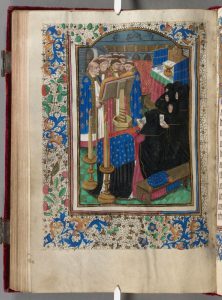
We’re sitting on the peak of a technological revolution. The past couple hundred years have radically changed the world, so it’s easy to distance ourselves from our predecessors, especially those from the Middle Ages. We have twitter, they had the bubonic plague; we have air conditioning, and they had the Medieval Inquisition. However, these differences are superficial (in a way). The people of the medieval world faced similar issues- unsure governments, war, disease, civil unrest- but while we reach outward to social media for comfort, they turned inwards to faith, specifically to Books of Hours.
A Book of Hours provides both spiritual guidance to the reader and physical reassurance of the owner’s faith; consider it the medieval equivalent to the newest IPhone. A phone is necessary now the way conforming to a specific faith was then, but paying for every new iteration of the IPhone is outlandishly expensive and impossible for a majority of the population, the same being applicable for a personally commissioned Book of Hours, let alone more than one. So, the question becomes why? I’d assert that a factor of the popularity of Books of Hours stems from external forces, namely unrest within the continent due to plague and persecution, unrest which sparked an uptick in outward shows and daily practices of devotion from laymen. (That isn’t to say that the popularity of Books of Hours among the upper class stemmed only from the prevalent issues of the time, a presumption which would be wholly incorrect, but it seems remiss to look at such an important type of medieval manuscript without taking into account its contemporary history.)
Books of Hours are “immediately recognizable symbol[s] of recollectedness, interiority, and prayer” (Duffy, 1). They are an outward sign of status, both material and spiritual, intended for the few devout (read, the wealthy) laymen. Their popularity, from the 12th century to the 15th century, corresponds with the time of the Medieval Inquisition, a precursor to the famously unexpected Spanish Inquisition and the period that set the stage for the witch hunts. A public display of Christian faith, especially one done in gold leaf, is a secure way to establish oneself.
The personalization of a Book of Hours relies highly on the purse of the person commissioning a copy. There are, of course, variations within the order and type of texts included, but the outstanding differences come in the type of illuminations. Self-insertion is the most prominent example that comes to mind. It’s a kind of primitive Photoshop, if you will. If spending an exorbitant amount of resources to buy a public symbol of faith wasn’t enough, some people commissioned artists to include their likeness within the Book of Hours, typically in a subservient or worshipful position before the Virgin Mary and Christ. Is there any better, or more expensive, way to demonstrate piety? I think not.
That isn’t to say that their piety was entirely a matter of showmanship. Inside that beautiful cover and next to elaborate miniatures are psalms and prayers intended to guide the user through a pious life. The Office of the Dead comes to mind- everyone was all too aware of their mortality, especially on account of the plague. Though the catastrophic outbreak that decimated a third of Europe’s population occurred in the mid 13th century, smaller outbreaks were common until the disappearance of the disease in the 17th century. The Book of Hours comes in as a way to help laymen deal with this loss, both as a record of the deceased and of the necessary prayers following a death. Some offices went bare, but some were preceded by lavish illustrations. For example, see the accompanying image from MS Richardson 34’s Office of the Dead, which includes careful detail to color, patterns, anatomy, and a vague awareness of depth perception on the part of the artist. The inclusion of such a detailed miniature speaks to the importance of the Office of the Dead as a part of the Book of Hours, and it is also indicative of the intrinsic value an illumination holds for the owner of a manuscript.
Of course, all of this comes with the caveat that only the upper class was able to acquire Books of Hours. Even with the invention of the printing press, elaborate manuscripts were still well out of reach for most laymen, and I have no doubt that those who couldn’t afford Books of Hours didn’t give them much thought; ownership implies a certain amount of leisure on the part of the reader, a luxury largely unavailable to the working classes.
Nevertheless, Books of Hours remain a reflection of the events and values of the period in which they were made. They’re not quite as accessible as the internet, nor are they as easy to navigate, but they allow us insight to the lives of people long gone. That, in itself, is a blessing.